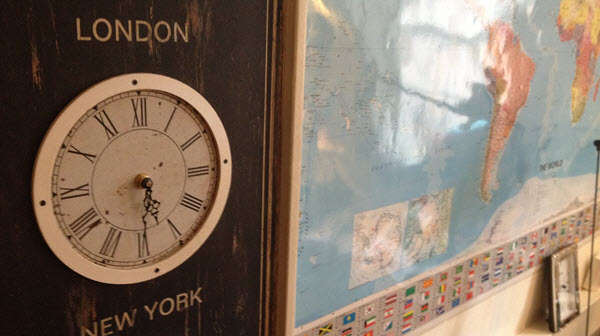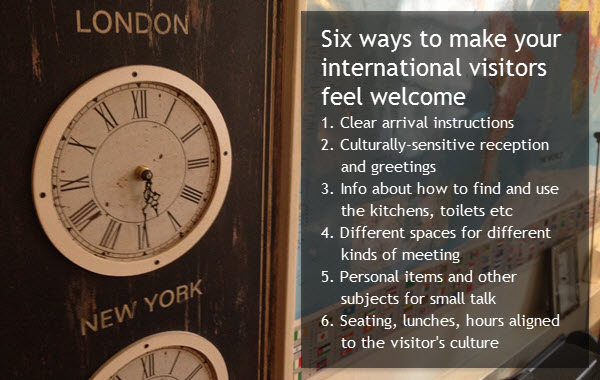How your office reflects the cross-cultural competence of your organization
Feb 4, 2016 · by Caroline Beery

Make your international visitors feel welcome with
- Arrival instructions
- Reception and greetings
- Facilities
- Ambience
- Items for small talk
- A cross-cultural approach
Innovative ideas and products often begin in domestic places: Laura Ashley’s attic flat, Apple in a garage, Harry Potter in a café. Whether myth or reality, there is some truth in our case at Argonaut. The idea of Argonaut came in a kitchen. In fact it was the kitchen of a renovated 17th century house in the middle of London.
Your business location is likely to be an office space in a city or a plant at the edge of an urban area, not a domestic setting. So how to offer a global welcome mat where you are? At Argonaut, we’ve been receiving guests of all cultures for many years and learned a few tricks for making international visitors welcome.
Welcome to the Argonaut offices

The old kitchen in the basement of the house is now the heart of the Argonaut offices with a front room where our daily work in cross cultural consultancy takes place, and a larger, adjoining room with chairs and sofas for client conversations and meetings. As this is an old London house, there are several levels, and meeting rooms continue on the first and second floors. Fireplaces were the providers of warmth in the centuries past and remain in working condition for added character and warmth.
Our offices have a history. The houses on Kensington Square were built and inhabited at the time that King William III and Queen Mary II moved to Kensington Palace (across the street in Kensington Gardens) in 1689. People who attended or served the court stayed in the Kensington Square houses.
Our current visitors represent a cross-section of a global society– an impressive cohort of diverse professions and cultures: HR managers, cross-cultural consultants and coaches, CEOs, international marketing professors, authors, editors, trainers, directors from many European, Asian, North and South American and African countries. These are clients and colleagues who have a shared commitment to the development of cross-cultural competence at every organizational level: individual, team, corporate.
As our offices are in an old house, what special characteristics make it a ‘come to’ place for clients and colleagues?
Top six ways to make your international visitors feel welcome
A location that’s easy to find
- Central location, convenient to public transportation and nearby landmarks
- Provide maps, local transport information, instructions for what to tell a taxi driver in harder-to-find locations
- List of local shops and services needed by visitors such as places of worship and places to buy local transport tickets, food, gifts, local and international food.
- Suggestions for local sights which take no longer than 1, 2, 3 hours
Reception and Greetings
- Reception staff informed about the name and cultural background of visitors in advance
- Introductions and tours with information about roles and seniority of people in the organisation
- Wifi information
Facilities
- Kitchens with clear signage or personal instructions about who can use it and how things work
- Accessible toilets and signs about how to use the items there, if there are any unusual aspects
Ambience
- A variety of spaces for meetings with differing levels of formality
- Conversational spaces with soft furniture, separate spaces for private talks, meeting rooms for formal discussions
Items to engage visitors in ‘small talk’
- Paintings, decorative items, interesting artefacts with an international theme or personal story, ideally with a connection to your current guest
- Personal items including family pictures, cards, books, team photos.
A cross-cultural approach
- Being sensitive to differing food requirements, both cultural and individual:, for example vegetarian diets; establishing the most appropriate time to meet during Ramadan or any religious holiday requirements or requests.
- Being aware of seating arrangements: who should have the most ‘prominent’ position if that is a consideration? Getting the right level of formality.
- Finding the right balance between small talk and getting down to business. Personal backgrounds and office history are openers for our client conversations. We move quickly or more slowly to the substance of the meeting depending on the questions and conversation that follow.
- Flexibility: professional hospitality means listening and watching for a visitor’s body language as well verbal language. Is he/she comfortable sitting, standing, with a table, without? With doors open, shut?
What has worked for you, and what would you add to this list?
